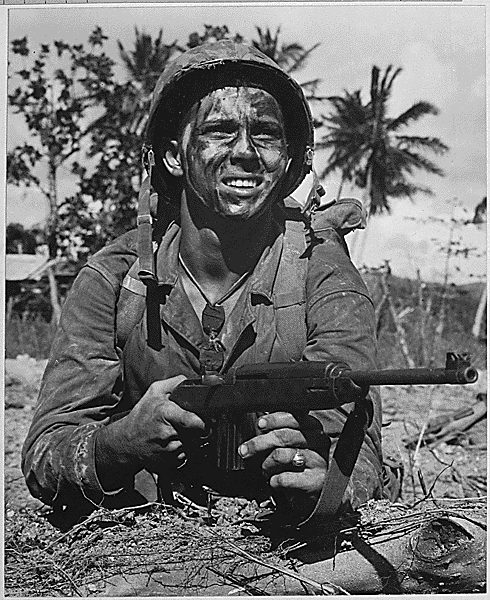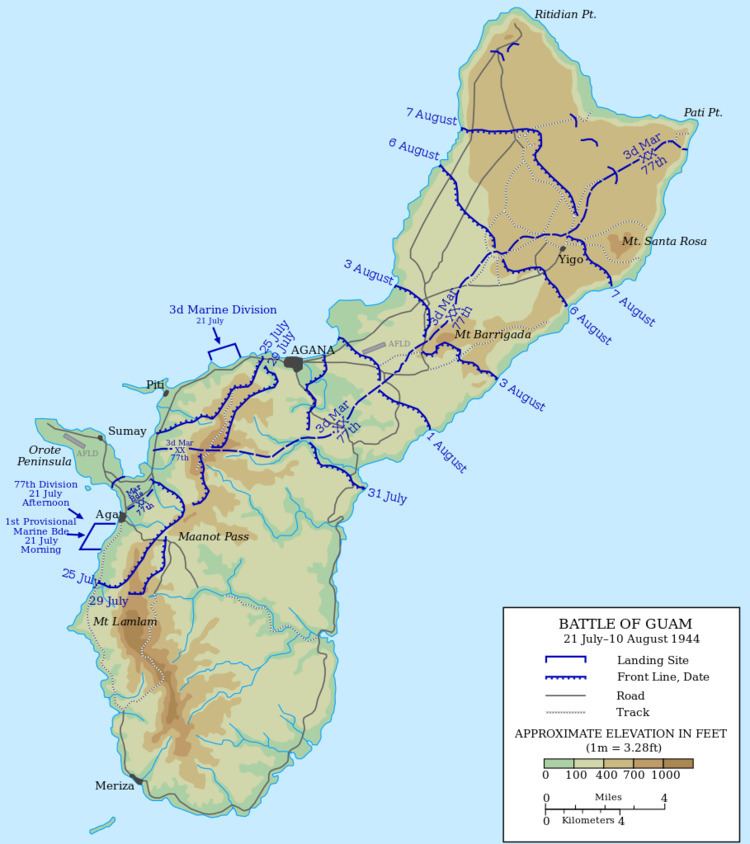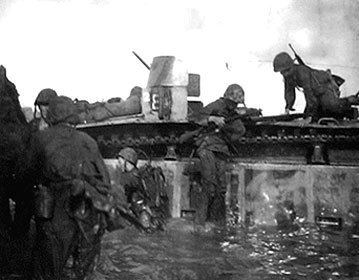59,401 18,65740 tanks Result American victory | Dates 21 Jul 1944 – 8 Aug 1944 | |
 | ||
3,000 killed,7,122 wounded 18,337 killed,1,250 POWs Similar World War II, Battle of Saipan, Battle of Tinian, Pacific War, Mariana and Palau Islands c | ||
Us marines and army beach assault second battle of guam 1944 men of war assault squad 2 gameplay
The Second Battle of Guam (21 July – 10 August 1944) was the American recapture of the Japanese-held island of Guam, a U.S. territory in the Mariana Islands captured by the Japanese from the U.S. in the 1941 First Battle of Guam during the Pacific campaign of World War II.
Contents
- Us marines and army beach assault second battle of guam 1944 men of war assault squad 2 gameplay
- wwii the battle of guam 1944 every day
- Background
- Battle of Guam
- Aftermath of battle
- Unit awards
- Medal of Honor recipients
- References

wwii the battle of guam 1944 every day
Background

Guam, at 212 square miles (341.18 square kilometers), is the largest island of the Marianas, with a length of 32 miles (52 km) and a width ranging from 12 miles (19.31 km) to 4 miles (6.44 km) at different points of the island. It had been a United States possession since its capture from Spain in 1898 until it was captured by the Japanese on 10 December 1941, following the attack on Pearl Harbor. It was not as heavily fortified as the other Mariana Islands such as Saipan that had been Japanese possessions since the end of World War I, but by 1944, Saipan had a large Japanese garrison.

The Allied plan for the invasion of the Marianas, Operation Forager, called for heavy preliminary bombardment, first by carrier aircraft and planes based in the Marshall Islands to the east, then once air superiority was gained, close bombardment by battleships. Saipan, Tinian, and Guam were chosen as targets due to their size, their suitability as a base for supporting the next stage of operations toward the Philippines, Taiwan and the Ryukyu Islands; the deep-water harbor at Apra was suitable for the largest ships; and airfields for Boeing B-29 Superfortresses could be built from which to bomb Japan.

The invasion of Saipan was scheduled for 15 June 1944, with landings on Guam tentatively set for 18 June. The original timetable was optimistic, however. A large Japanese carrier attack and stubborn resistance by the unexpectedly large Japanese garrison on Saipan led to the invasion of Guam being postponed for a month.

U.S. naval and air bombardments lasted from 11–13 June 1944, involving 216 carrier aircraft and land based B-24 bombers. On the 12th and 13th of the month, 12 Japanese cargo ships and several fishing vessels were sunk. On June 27, U.S. battleships started shelling the island, joined by a U.S. carrier group on 4 July, and two more on 6 July, with the total loss of 16 U.S. aircraft.
Battle of Guam
Guam, ringed by reefs, cliffs, and heavy surf, presents a formidable challenge for an attacker. Underwater demolition teams reconnoitered the beaches and removed obstacles from 14–17 July. Despite the obstacles, on 21 July, the American forces landed on both sides of the Orote Peninsula on the western side of Guam, planning to secure Apra Harbor. The 3rd Marine Division landed near Agana to the north of Orote at 08:29, and the 1st Provisional Marine Brigade landed near Agat to the south. Japanese artillery sank 20 U.S. LVTs and inflicted heavy casualties on the landing troops, especially of the 1st Provisional Marine Brigade, but by 09:00 men and tanks were ashore at both beaches.
By nightfall, the U.S. Marines and soldiers had established beachheads about 6,600 feet (2,000 m) deep. Japanese counterattacks were made throughout the first few days of the battle, mostly at night, using infiltration tactics. Several times the Japanese penetrated the American defenses and were driven back with heavy losses of men and equipment.
The U.S. Army's 77th Infantry Division had a more difficult landing on 23–24 July. Lacking amphibious vehicles, they had to wade ashore from the edge of the reef where the landing craft dropped them off. The men stationed in the two beachheads were pinned down by heavy Japanese fire, making initial progress inland quite slow. Supply was very difficult for the landing troops on Guam in the first days of the battle. Landing ships could not come closer than the reef, several hundred yards from the beach, and amphibious vehicles were scarce.
The 1st Provisional Brigade blocked off the Orote Peninsula on 25 July, and that same night Japanese Lt. General Takeshi counterattacked, coordinated with a similar attack against the 3rd Division to the north. The next day, General Obata reported, "our forces failed to achieve the desired objectives." Lieutenant General Takeshi Takashina was killed on 28 July, and Lieutenant General Hideyoshi Obata took over the command of the Japanese defenders. On 28 July, the two beachheads were linked, and by 29 July, the Americans secured the peninsula.
The Japanese counterattacks against the American beachheads, as well as the fierce fighting, had exhausted the Japanese. At the start of August, they were running out of food and ammunition and had only a handful of tanks left. Obata withdrew his troops from the south of Guam, planning to make a stand in the mountainous central and northern part of the island, "to engage in delaying action in the jungle in northern Guam to hold the island as long as possible".
After ensuring no significant Japanese forces operated in the southern portion of Guam, Marine Major General Geiger started an offensive north with the 3rd Marine Division on the left flank, and the 77th Infantry Division on the right, liberating Agana on the same day. The Tiyan Airfield was captured on 1 Aug.
Rain and thick jungle made conditions difficult for the Americans, but after an engagement with the main Japanese line of defense around Mount Barrigada from 2–4 August, the Japanese line collapsed. The 1st Provisional Brigade formed up on the left flank of the 3rd Marine Division on 7 August, due to the widening front and continued casualties, in an effort to prevent the Japanese from slipping through the American gaps. The Japanese had another stronghold at Mount Santa Rosa, which was secured on 8 Aug.
On 10 August, organized Japanese resistance ended, and Guam was declared secure, though 7,500 Japanese soldiers were estimated to be at-large. The next day, Obata committed ritual suicide at his headquarters on Mount Mataguac after he had sent a farewell message to Japan.
Aftermath of battle
A few Japanese soldiers held out in the jungle after the fighting on Guam. On 8 December 1945, three U.S. Marines were ambushed and killed. On 24 January 1972, Japanese Army Sergeant Shoichi Yokoi was discovered by hunters on the island. He had lived alone in a cave for 28 years near Talofofo Falls.
Guam was turned into a base for Allied operations after the battle. Five large airfields were built by the Navy Seabees, and Army Air Forces B-29 bombers flew from Northwest Field and North Field on Guam to attack targets in the Western Pacific and on mainland Japan.
Liberation Day continues to be celebrated on Guam every 21st of July.
Unit awards
Medal of Honor recipients
Four Medal of Honor recipients of the Battle of Guam:
